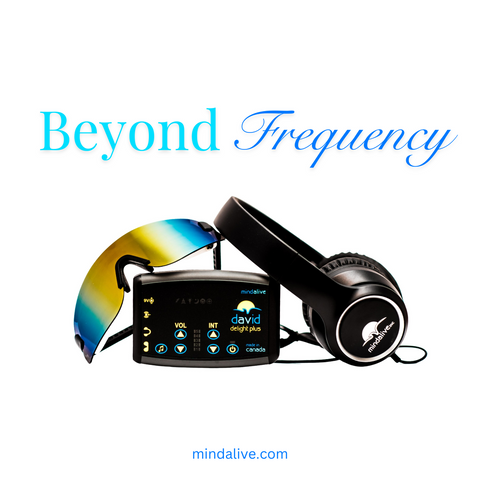“What frequency do I want to use?” “What session should I select?” These are probably the most common questions people ask us here at Mind Alive.
In our book “The Rediscovery of Audio-Visual Entrainment” we focused a lot on the frequency of the flashing of the lights and the pulsing of the tones as the cause of the benefits of Audio-Visual Entrainment (AVE). Specific brainwaves were associated with certain characteristics. For example, beta brain waves (12 Hz – 34 Hz) are associated with performing cognitive functions such as solving a math problem. However, producing too much beta in relation to alpha was found in hyper vigilance and some forms of anxiety. Alpha (8 Hz – 12 Hz) is the idling rhythm and is associated with relaxation and meditation, but excess slowed alpha can be seen in ADD and dementia. Theta brain waves (5 Hz – 7 Hz) are associated with dreamlike states of consciousness, but excess theta can be seen in ADHD. Delta waves (1 Hz – 4 Hz) are necessary for sleep, but low voltage delta without K-complexes is associated with poor sleep where proteins build up and lead to Alzheimer’s, Parkinson’s, and Chronic Traumatic Encephalopathy (CTE). It was commonly believed that the most effective use of AVE was to guide the brain into specific desired brainwave states. We are also learning a lot more about gamma brainwaves, which are the fastest frequency (35 Hz - 100 Hz). They are associated with heightened perception, problem solving, and peak performance. Gamma brainwaves are associated with the synchronization of brain activity and integrating information from different areas of the brain.
More recently, we have been observing using frequencies that would be counter intuitive to reaching desired results. For example, when we were first designing research studies, we developed a sub-delta session that we assumed would be so slow, it wouldn’t possibly have an entraining effect and was used as our placebo session. Surprisingly, we found this session effective for fibromyalgia. Symptomatically, it appears that sub-delta affects the hypothalamus. Given that the hypothalamus regulates most autonomic functioning, idiopathic problems are sometimes resolved with slow AVE. For example, people struggling with idiopathic fibromyalgia and those with idiopathic hypertension often respond well to sub-delta stimulation.
Another counter intuitive use of AVE we observed is with those who have a post-inflammatory condition known as a thalamocortical disconnect. This is a debilitating condition that follows inflammation from mild brain injuries such as concussions and post-viral infections (for example COVID) or even heading a soccer ball. Neurologically, it is a condition where the rhythms to the thalamus stop happening. Both alpha and delta waves are attenuated or disappear completely. It expresses itself as general anxiety, severe insomnia, and obsessive compulsiveness. Because this condition involves a loss of cerebral blood flow, lactate (an enzyme) and ATP (a nucleotide), plus circulation of cerebral spinal fluid, a simple frequency-based AVE model doesn’t apply. Surprisingly randomized SMR-Beta stimulation and likely gamma stimulation reestablish alpha production by reconnecting the pathways to the thalamus.
In addition to guiding brainwaves to desired frequencies, AVE also benefits the brain by:
· Inducing healthy dissociation and restabilization which breaks the HPA axis (fight-or-flight activation – fear response)
· Increasing cerebral blood flow by 28%
· Balancing neurotransmitters (specifically serotonin, norepinephrine, endorphins, and melatonin)
· Increasing in lactate and ATP – energy source for all of our cells – neurons use a lot
· Increasing heat shock protein 70 (HSP70) which protects brain from viral infections, etc.
· Activating glia which clean up deposits in brain
· Increasing non-inflammatory cytokines which nourish the neurotransmitters
· Increasing circulation of cerebral spinal fluid
· Improving neuronal stamina.
There is so much more for us to discover and observe about how AVE affects the brain and mental functioning. That is why, at Mind Alive, we are committed to research and learning in order to offer AVE as a viable, reliable, effective way to increase our overall well-being.
Beyond Frequency
